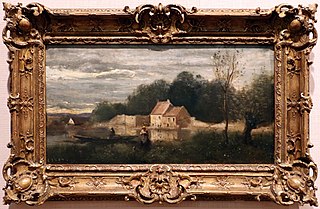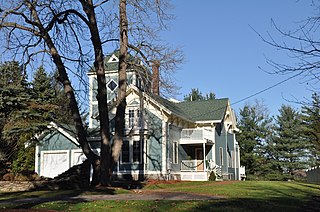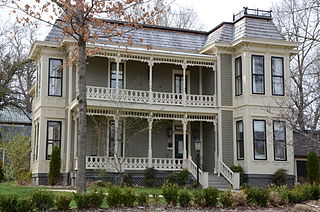
A door is a hinged or otherwise movable barrier that allows ingress (entry) into and egress (exit) from an enclosure. The created opening in the wall is a doorway or portal. A door's essential and primary purpose is to provide security by controlling access to the doorway (portal). Conventionally, it is a panel that fits into the doorway (portal) of a building, room, or vehicle. Doors are generally made of a material suited to the door's task. Doors are commonly attached by hinges, but can move by other means, such as slides or counterbalancing.

Lumber, also known as timber, is wood that has been processed into beams and planks, a stage in the process of wood production. Lumber is mainly used for structural purposes but has many other uses as well.

In architecture, the frieze is the wide central section part of an entablature and may be plain in the Ionic or Doric order, or decorated with bas-reliefs. Paterae are also usually used to decorate friezes. Even when neither columns nor pilasters are expressed, on an astylar wall it lies upon the architrave and is capped by the moldings of the cornice. A frieze can be found on many Greek and Roman buildings, the Parthenon Frieze being the most famous, and perhaps the most elaborate. This style is typical for the Persians.

The Eastlake movement was a nineteenth-century architectural and household design reform movement started by British architect and writer Charles Eastlake (1836–1906). The movement is generally considered part of the late Victorian period in terms of broad antique furniture designations. In architecture the Eastlake style or Eastlake architecture is part of the Queen Anne style of Victorian architecture.

A structural insulated panel, or structural insulating panel, (SIP), is a form of sandwich panel used in the construction industry.

Moulding, also known as coving(United Kingdom, Australia), is a strip of material with various profiles used to cover transitions between surfaces or for decoration. It is traditionally made from solid milled wood or plaster, but may be of plastic or reformed wood. In classical architecture and sculpture, the molding is often carved in marble or other stones.

A coping saw is a type of bow saw used to cut intricate external shapes and interior cut-outs in woodworking or carpentry. It is widely used to cut moldings to create coped rather than mitre joints. It is occasionally used to create fretwork though it is not able to match a fretsaw in intricacy of cut, particularly in thin materials. Coping saw blades are always thicker and much coarser cutting than typical fretsaw blades and many others of its family members. Coping saws can however cut slight bends in the work, allowing circles to be cut if used carefully.

In foundry work, the terms cope and drag refer respectively to the top and bottom parts of a two-part casting flask, used in sand casting. The flask is a wood or metal frame, which contains the molding sand, providing support to the sand as the metal is poured into the mold. In flaskless molding, the same terms are used, cope for the top or upper piece and drag for the bottom or lower piece.

Frame and panel construction, also called rail and stile, is a woodworking technique often used in the making of doors, wainscoting, and other decorative features for cabinets, furniture, and homes. The basic idea is to capture a 'floating' panel within a sturdy frame, as opposed to techniques used in making a slab solid wood cabinet door or drawer front, the door is constructed of several solid wood pieces running in a vertical or horizontal direction with exposed endgrains. Usually, the panel is not glued to the frame but is left to 'float' within it so that seasonal movement of the wood comprising the panel does not distort the frame.

Framing, in construction, is the fitting together of pieces to give a structure support and shape. Framing materials are usually wood, engineered wood, or structural steel. The alternative to framed construction is generally called mass wall construction, where horizontal layers of stacked materials such as log building, masonry, rammed earth, adobe, etc. are used without framing.

Kitchen cabinets are the built-in furniture installed in many kitchens for storage of food, cooking equipment, and often silverware and dishes for table service. Appliances such as refrigerators, dishwashers, and ovens are often integrated into kitchen cabinetry. There are many options for cabinets available at present.

A picture frame is a protective and decorative edging for a picture, such as a painting or photograph. It makes displaying the work safer and easier and both sets the picture apart from its surroundings and aesthetically integrates it with them.

Coping or scribing is the woodworking technique of shaping the end of a moulding or frame component to neatly fit the contours of an abutting member. Joining tubular members in metalworking is also referred to as a cope, or sometimes a "fish mouth joint" or saddle joint.
This glossary of woodworking lists a number of specialized terms and concepts used in woodworking, carpentry, and related disciplines.

A flask is a type of tooling used to contain a mold in metal casting. A flask has only sides, and no top or bottom, and forms a frame around the mold, which is typically made of molding sand. The shape of a flask may be square, rectangular, round or any convenient shape. A flask can have any size so long as it is larger than the pattern being used to make the sand mold. Flasks are commonly made of steel, aluminum or even wood. A simple flask has two parts: the cope and the drag. More elaborate flasks may have three or even four parts.

Cross-laminated timber (CLT) is a wood panel product made from gluing together layers of solid-sawn lumber, i.e., lumber cut from a single log. Each layer of boards is usually oriented perpendicular to adjacent layers and glued on the wide faces of each board, usually in a symmetric way so that the outer layers have the same orientation. An odd number of layers is most common, but there are configurations with even numbers as well. Regular timber is an anisotropic material, meaning that the physical properties change depending on the direction at which the force is applied. By gluing layers of wood at right angles, the panel is able to achieve better structural rigidity in both directions. It is similar to plywood but with distinctively thicker laminations.

The Amos Morse House was a historic house at 77 North Street in Foxborough, Massachusetts. It was a two-story wood-frame house, five bays wide, with a hip roof and twin interior chimneys. It was a center entry, Federal Colonial design. It was built circa 1803 by Amos Morse, Sr., for his children, Amos Jr. and Sarah. One of its ells was used by the Morses as a shop for producing straw hats, a significant industry in early 19th-century Foxborough.

Lynnwood is a historic house at 5 Linden Avenue in Wakefield, Massachusetts. Built c. 1858, it is one of the town's finest examples of Stick style architecture. It is a 1+1⁄2-story wood-frame structure with an L-shaped cross-gable configuration; its features include deep eaves supported by arched brackets, and a 3+1⁄2-story tower topped by a hip roof with triangular dormer windows. Its eaves have brackets with pendants, and its windows have surrounds with drip molding.

The Rice House is a historic house at 501 NW "A" Street in Bentonville, Arkansas. It is a 2+1⁄2-story wood-frame structure with elaborate Eastlake styling. Characteristics of the style include jigsaw-cut bracketing, spindled balustrades, and molded panels under the windows. At the time of its construction in 1890, it was considered one of Bentonville's grandest houses. The house was listed on the National Register of Historic Places in 1988.

Construction adhesive is a general-purpose adhesive used for attaching drywall, tile, molding, and fixtures to walls, ceilings, and floors. It is most commonly available in tubes intended for use with a caulking gun.


















